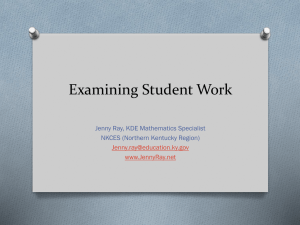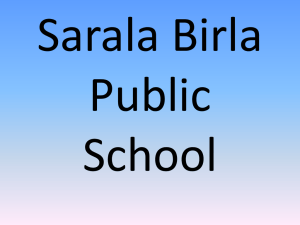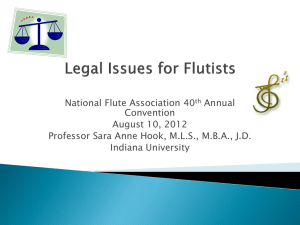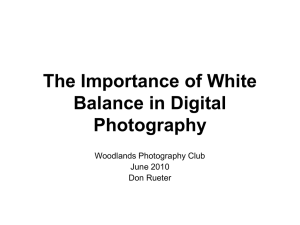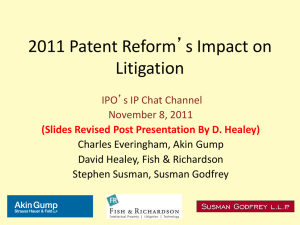Understanding The Leahy-Smith America Invents Act
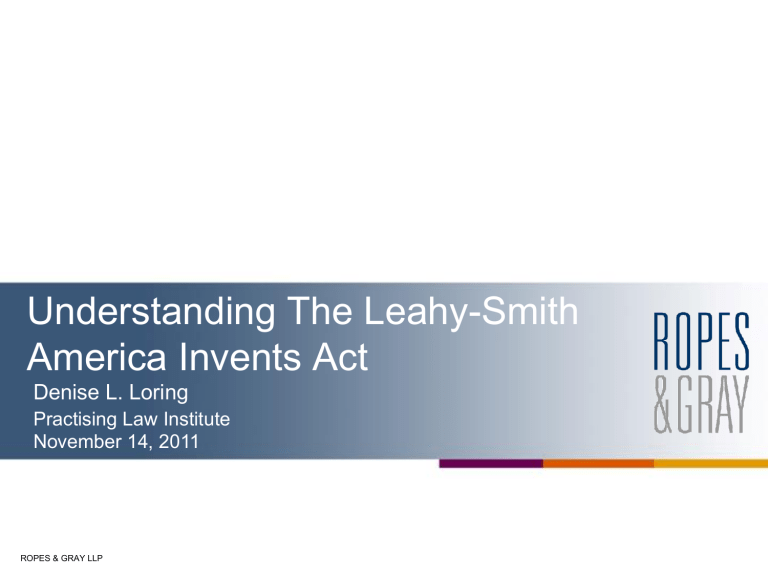
Understanding The Leahy-Smith
America Invents Act
Denise L. Loring
Practising Law Institute
November 14, 2011
ROPES & GRAY LLP
Historical Overview
2 ROPES & GRAY
Historical Overview
• June 8, 2005 –109 th Congress began to consider patent reform
– 110 th and 111 th Congresses followed suit, but no legislation was passed
• January 25, 2011 – Senate introduced S. 23, the
Patent Reform Act of 2011 (later renamed, the
“America Invents Act”)
– Main goals:
1.
Improve the patent application process by adopting a firstto-file system
2.
Improve the quality of patents issued by the USPTO by adopting broader post-grant review procedures
3.
Increase certainty in litigation
3 ROPES & GRAY
Historical Overview
• March 7, 2011 – FTC published The Evolving IP
Marketplace: Aligning Patent Notice and
Remedies with Competition
– Recognized:
• Importance of innovation
• Vital role of well-defined patents in promoting innovation
• Harmful effect of “patent market”
• Role of non-practicing entities (NPE’s) in increasing litigation
– Two Main Foci:
• Notice function of patents
• Remedies for patent infringement
27989303 ROPES & GRAY
27989303
Historical Overview
– FTC recommendations:
Notice Function of Patents
• Stricter enforcement of
35 U.S.C.
§ 112 ¶ 2
• Increase level of detail in prosecution history record
• Publish patent applications after 18 months
• Shorten review period
• Improve patent searches
(especially in high-tech sector)
Remedies for Patent
Infringement
• Align lost profit and reasonable royalty awards with patent value
• “Entire market value” rule: hypothetical negotiation focusing on the time alleged infringement began to calculate reasonable royalty damages
• Discourage use of reasonable royalties to deter infringement
• Discourage use of unproven lost profit claims to increase reasonably royalty awards
ROPES & GRAY
Historical Overview
• March 8, 2011 – Senate passed S. 23
• June 23, 2011 – House of Representatives passed H.R. 1249, the “Leahy-Smith America
Invents Act”
• September 8, 2011 – Senate adopted H.R. 1249 without amendment
• September 16, 2011 – President Obama signed the Act into law
6 ROPES & GRAY
Overview
• First-inventor-to-file
• Inventor declarations and non-inventor application filings
• Validity and infringement defenses
• Third-party intervention
• Supplemental examination
• Federal court jurisdiction
• Impact on patent infringement litigation
7 ROPES & GRAY
First-Inventor-To-File
8 ROPES & GRAY
Section 102 – First-Inventor-to-File
• 35 U.S.C. § 102 wholly rewritten
• Two classes of prior art:
– Patents and published patent applications, and
– all other public disclosures
• Prior art inquiry now keyed to effective filing date, rather than date of invention
– First to file, not first to invent
9 ROPES & GRAY
Section 102(a) – Novelty, Prior Art
• Removes territoriality – no “in this country” restriction on prior art
• Foreign applicants no longer need to rely upon a “section 102(e)” date – foreign priority dates treated on a par with U.S. filings
10 ROPES & GRAY
Section 102(b) – Grace Period
• Provides two exceptions to prior art
– One-year grace period for filing if inventor or assignee makes public disclosure
– A company’s own applications are not prior art against its later applications
• Applications filed pursuant to joint research agreements are not prior art against each other
• Similar to current system, but protects only against inventor’s own disclosures or patent applications
11 ROPES & GRAY
Section 102(b) – Grace Period
• Once an inventor discloses invention, that disclosure may be used as a shield against later disclosures and patent filings
– Open question: do “public disclosures” encompass sales, public use?
• Potential strategy: disclose early as a sword against others’ filings, a shield against others’ disclosures
– But only if foreign rights are not important
12 ROPES & GRAY
Section 102(b) – Derivation
• Also provides protection from earlier disclosures and patent filings if the information was obtained directly or indirectly from the actual inventors
– Grace period only one year for public disclosures, but unlimited for patent filings
13 ROPES & GRAY
Section 102(d) – Prior Art Dates
• Affirms that any priority date is the effective filing date of a U.S. patent or application cited as prior art
– whether prior art is a provisional application, a utility application, or even a PCT or foreign patent application
– Still requires adequate disclosure in the priority document
14 ROPES & GRAY
Section 102 – Timing
• Provisions generally take effect 18 months after enactment
– Applies to applications filed on or after effective date
– Later-filed applications claiming priority to earlier applications are governed by first-to-invent system
15 ROPES & GRAY
Section 103 – Obviousness
• Essentially unchanged, except that prior art status based on filing date instead of invention date
16 ROPES & GRAY
Section 135 – Derivation
Proceedings in the PTO
• A later applicant may assert that an earlier applicant derived the claimed invention and filed without authorization
• Effectively replaces interference proceedings
– Question now revolves around single act of invention, rather than competing acts of invention
• Remedy is cancellation/refusal of derived claims
17 ROPES & GRAY
Section 135 – Derivation
Proceedings
• Timing: petition must be filed within one year of publication of a competitor’s application
• Pays to monitor competitors’ applications early in the filing process
18 ROPES & GRAY
Section 291 – Derivation Actions
• Similar provision for patent owners to sue in court, alleging that a third-party patent was derived from the inventors’ work
• Must sue within a year of patent issuance
19 ROPES & GRAY
Inventor Declarations And Non-
Inventor Application Filings
20 ROPES & GRAY
Section 115 – Inventor
Declarations
• Requires statement that inventor authorized filing
– Companies may want to obtain blanket authorizations from potential inventors to avoid problems
• All required statements can be included in assignment document – no need for separate declaration
• Effective one year from date of enactment
21 ROPES & GRAY
Section 118 – Assignee Filing of
Patent Applications
• Non-inventors may apply for patents:
– Persons to whom the inventor has assigned or is under an obligation to assign the invention
– Persons who show “sufficient proprietary interest” in the subject matter “on behalf of and as agent for” the inventors
• Patents granted to “real party in interest”, upon notice to inventor
• Effective one year after date of enactment
• Applies to any patent application filed on or after the effective date
22 ROPES & GRAY
Validity And Infringement Defenses
ROPES & GRAY 23
Section 282 – Best Mode
• Best mode is no longer available as basis for invalidity or unenforceability of an issued patent
• Obligation to disclose best mode in application remains
• Effective upon date of enactment
• Applies to all proceedings filed on or after enactment
24 ROPES & GRAY
Patent Marking
• False patent marking greatly curtailed
– Response to recent surge in qui tam litigation
– No statutory damages for private litigants; can only obtain actual damages
– Marking a product with expired patent number that once covered the product is not a violation
• Virtual marking permitted
– Marking may be achieved by posting patent information online
• Effective upon date of enactment
– Applies to any case pending or commenced on or after date of enactment
25 ROPES & GRAY
Section 273 – Prior User Rights
• Defense to infringement if:
– defendant had been commercially using a patented process, or machine, manufacture, or composition useful in that process,
– at least one year before patentee’s effective filing date or earlier publication (i.e., grace period)
• No longer just for business methods
• Burden on prior user to prove use by clear and convincing evidence
26 ROPES & GRAY
Section 273 – Prior User Rights
• Regulatory review periods and non-profit laboratory use count as commercial use
• Defense is personal, and can be transferred only with transfer of entire enterprise or line of business protected by defense
– Scope of defense is limited after transfer
• Downstream purchasers of accused product protected by patent exhaustion
ROPES & GRAY
Section 298 – Willful Infringement
• Failure to obtain advice of counsel with respect to an asserted patent does not create an inference of willful patent infringement
– Codifies Knorr-Bremse Systeme Fuer Nutzfahrzeuge
GmbH v. Dana Corp.
, 383 F.3d 1336 (Fed. Cir. 2004)
• Effective one year after date of enactment
• Applies to any patent issued on or after the effective date
28 ROPES & GRAY
Third Party Intervention
29 ROPES & GRAY
Third Party Intervention
• Preissuance submission
• Post-grant review
• Inter partes review
• Post-grant submission
30 ROPES & GRAY
Section 122(e) – Preissuance
Submission
• Any person may submit patents and printed publications for review before the earlier of:
– date of allowance; or
– later of:
• six months after the patent application publishes, or
• first rejection of any claim
• Effective one year after date of enactment
31 ROPES & GRAY
Sections 321-29 – Post-Grant
Review
• A third party may petition the USPTO to institute post-grant review of a patent
– Petition must name real party in interest
• Petitioner may request cancellation claims as unpatentable on virtually any ground:
– E.g.
, prior art, written description, enablement, utility, or patentable subject matter
• Heard by Patent Trial and Appeal Board
32 ROPES & GRAY
Sections 321-29 – Post-Grant
Review
• Petition must be filed within nine months of patent grant
– Or within nine months of reissue, if claims were broadened
• Review standard:
– Petition, taken alone, would make it more likely than not that at least one claim is unpatentable; or
– Petition raises novel or unsettled legal question that would be important to other patents or applications
33 ROPES & GRAY
Sections 321-29 – Post-Grant
Review
• Effective one year after date of enactment
• Applies only to patents subject to first-tofile rules
34 ROPES & GRAY
Transitional Post-Grant Review for
Business Method Patents
• Special program creates eight-year period during which a person charged with infringement of a business method patent may file a petition for post-grant review
– Applies to any business method patent, regardless of its filing date
• Effective one year after date of enactment
35 ROPES & GRAY
Sections 311-15 – Inter partes
Review
• Challenges to validity based on patents or printed publications only
• Replaces inter partes reexamination
• Review standard
– There is a reasonable likelihood that petitioner would prevail with respect to at least one claim
• Heard by Patent Trial and Appeal Board
(not examiner)
36 ROPES & GRAY
Sections 311-15 – Inter partes
Review
• Post-grant review and litigation affect availability of inter partes review
– May not be filed before the deadline to file a postgrant review petition or during a post-grant review proceeding
– Not available if petitioner previously filed a lawsuit challenging the validity of the patent
– Not available if the petition is filed more than 12 months after the petitioner is sued for infringement of the patent
37 ROPES & GRAY
Sections 311-15 – Inter partes
Review
• Effective one year after date of enactment
• In the interim, standard for instituting inter partes reexamination is changed to new, inter partes review standard
• Applies to all existing patents, subject to timing restrictions
38 ROPES & GRAY
Post-Grant and Inter Partes Review
• Common provisions
– USPTO required to make final determination within one year, with six-month extension for good cause
– Estoppels bar any defense that was or reasonably could have been raised during review
– No review may be filed if petitioner files an action challenging patent validity
– Any declaratory judgment action challenging validity filed after the petition is automatically stayed, unless patentee moves to lift the stay or files its own action
39 ROPES & GRAY
Section 301 – Post-Grant
Submission
• Any person may submit to USPTO at any time patents or printed publications believed relevant to patentability of any patent claim
• Optional statement of relevance
– Becomes part of official public file if it explains how the prior art is applicable to at least one patent claim
• Optional request for confidentiality
• Does not trigger any proceeding
40 ROPES & GRAY
Supplemental Examination
41 ROPES & GRAY
Section 257 – Supplemental
Examination
• New procedure for patentees
• Patentees may request examination to consider, reconsider, or correct information relevant to patentability
• USPTO must conduct examination within three months to determine whether substantial new question of patentability is raised
– If so, reexamination is ordered
• Newly disclosed information may not be used as a basis for asserting inequitable conduct
42 ROPES & GRAY
Section 257 – Supplemental
Examination
• Protection from inequitable conduct claim does not apply:
– To allegations pleaded with particularity in litigation before examination request is filed
– If patentee files patent infringement suit before supplemental examination is concluded
• Effective one year after date of enactment
• Can be applied retroactively to existing patents
43 ROPES & GRAY
Effective Dates of AIA Provisions
Immediate – 9/16/2011 One Year – 9/16/2012 18 Months – 3/16/2013
• Joinder restrictions • Post-grant review
• Change in standard for • Except for business initiating inter partes method patents and reexamination pending interferences; only for patents subject
• Limits on false marking to first-to-file rules suits
• New inter partes
• Virtual marking review
• Prior user rights • Preissuance
• No best mode defense submissions
• Supplemental examination
• Willful infringement
• First-to-file
• New §102; changes in prior art status
ROPES & GRAY
Federal Court Jurisdiction
45 ROPES & GRAY
Section 299 – Joinder of Parties
• A patent owner may only join multiple defendants in one action if:
– the right to relief arises out of the same events relating to the infringement; and
– there are questions of fact common to all of the defendants
• Effective upon date of enactment
• Applies to any court action filed on or after enactment
• Exception for ANDA litigation
46 ROPES & GRAY
Impact Of AIA On
Patent Infringement Litigation
47 ROPES & GRAY
27989303
Impact on Patent Quality
• Hasty filing of applications may result in inadequate disclosures
• Adverse effects on small businesses and sole inventors
• Burden on patent examiners to review more and greater variety prior art
• Strain on USPTO resources resulting from new post-grant proceedings
ROPES & GRAY
Impact on Litigation – First-to-File
• Expands prior art available to invalidate patent claims
– Patentees may no longer antedate third party prior art before a patent’s effective filing date
• Patents, printed publications, prior public use, prior sale or offer for sale
– Public use and sales outside of the U.S. are now available as prior art
• This could lead to increased litigation costs as defendants engage in third party discovery to prove up prior art
49 ROPES & GRAY
Impact on Litigation – Validity
• Eliminates some invalidity defenses in litigation
– Prior invention (old Section 102(g))
– Failure to disclose the best mode
– False marking defense reserved for those suffering actual injury
50 ROPES & GRAY
Impact on Litigation – Infringement
• Expansion of prior user defense to all patents, not just business method patents
– Effectively replaces prior invention invalidity defense with personal non-infringement defense
• Codifies existing restrictions on availability of willful infringement claim
51 ROPES & GRAY
Impact on Litigation – Inequitable
Conduct
• Attempts to curtail inequitable conduct in prior bills were eliminated from Act
– Recent Federal Circuit decision in Therasense may eliminate need for statutory reform
• Supplemental examination may provide limited means to cure alleged inequitable conduct
– But only if examination is sought before the defense is raised in litigation
52 ROPES & GRAY
Impact on Patent Infringement
Litigation – Damages
• No changes to damages calculation
– Once a hot issue, now widely considered to have been resolved by the courts
53 ROPES & GRAY
Impact on Patent Infringement
Litigation –Post-Grant Reviews
• Expansion of grounds for invalidity that USPTO may consider in post-grant review
– Absence of live testimony before USPTO limits nature of evidence to be considered
• Reduction in ability to use reviews as tactic to delay district court litigation
– Reviews must be completed within one year, vs. three years for inter partes reexamination
– Ban against filing petition for inter partes review 12 months after commencement of litigation
• May further strain already limited resources of the
USPTO
54 ROPES & GRAY
Impact on Litigation – District Court vs. USPTO Proceedings
• Post-grant and inter partes reviews may shift validity challenges to USPTO
– Estoppels barring litigation in court of questions that could have been raised during post-grant or inter partes reviews
– Transitional post-grant review of business method patents, regardless of date of issuance
• Restrictions on joinder of unrelated parties in a single litigation aimed at curtailing non-practicing entity litigation
– Federal courts still have discretion under Federal
Rules to join parties for efficiency
55 ROPES & GRAY
Thank You
Denise L. Loring
Ropes & Gray LLP
1211 Avenue of the Americas
New York, NY 10036
212-596-9069 denise.loring@ropesgray.com
56 ROPES & GRAY


